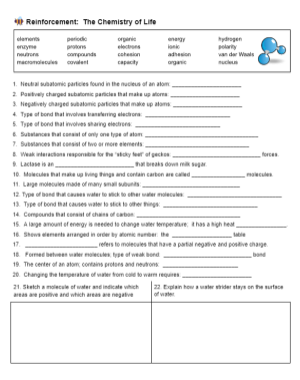
This vocabulary exercise aligns with Chapter 2 of the Miller and Levine Bee Book. This chapter focuses on basic concepts of chemistry, like the structure of the atom and types of bonds.
I design these worksheets as a way for students to engage with key terms in the textbook. Generally, students do the reinforcement activity the day before the chapter test. I give students about 15 minutes to work independently or in pairs to answer the questions on the sheet.
Then, I project the worksheet on the board and have students come up to write in the answers so that other students can check their work. This eliminates the need for me to grade the worksheet and return it before students take the test. Plus, it saves time!
So what are the key terms in this chapter?
Atoms
Atoms are the basic units of matter. Everything around us, including our bodies, is made of atoms. Atoms are like tiny, invisible Lego pieces that come together to form everything we see. Each atom has three main parts:
- Protons: Positively charged particles found in the center (nucleus) of the atom.
- Neutrons: Neutral particles, also in the nucleus.
- Electrons: Negatively charged particles that orbit the nucleus.
Molecules
When atoms join together, they form molecules. Molecules are like words made up of letters (atoms). For example, water (H₂O) is a molecule made of two hydrogen atoms and one oxygen atom.
Macromolecules (Carbon Compounds)
- Carbohydrates
- Proteins
- Lipids
- Nucleic Acids
Properties of Water
- Polarity
- Cohesion
- Adhesion
- Heat Capacity
- Universal Solvent
More Resources on The Chemistry of Life
You can find the slides I use in class with outline on the Biology 1 and 1A page. This chapter I try to do fairly quickly, as many of the students had physical science in the 8th grade. I mainly focus on biological macromolecules and properties of water.

